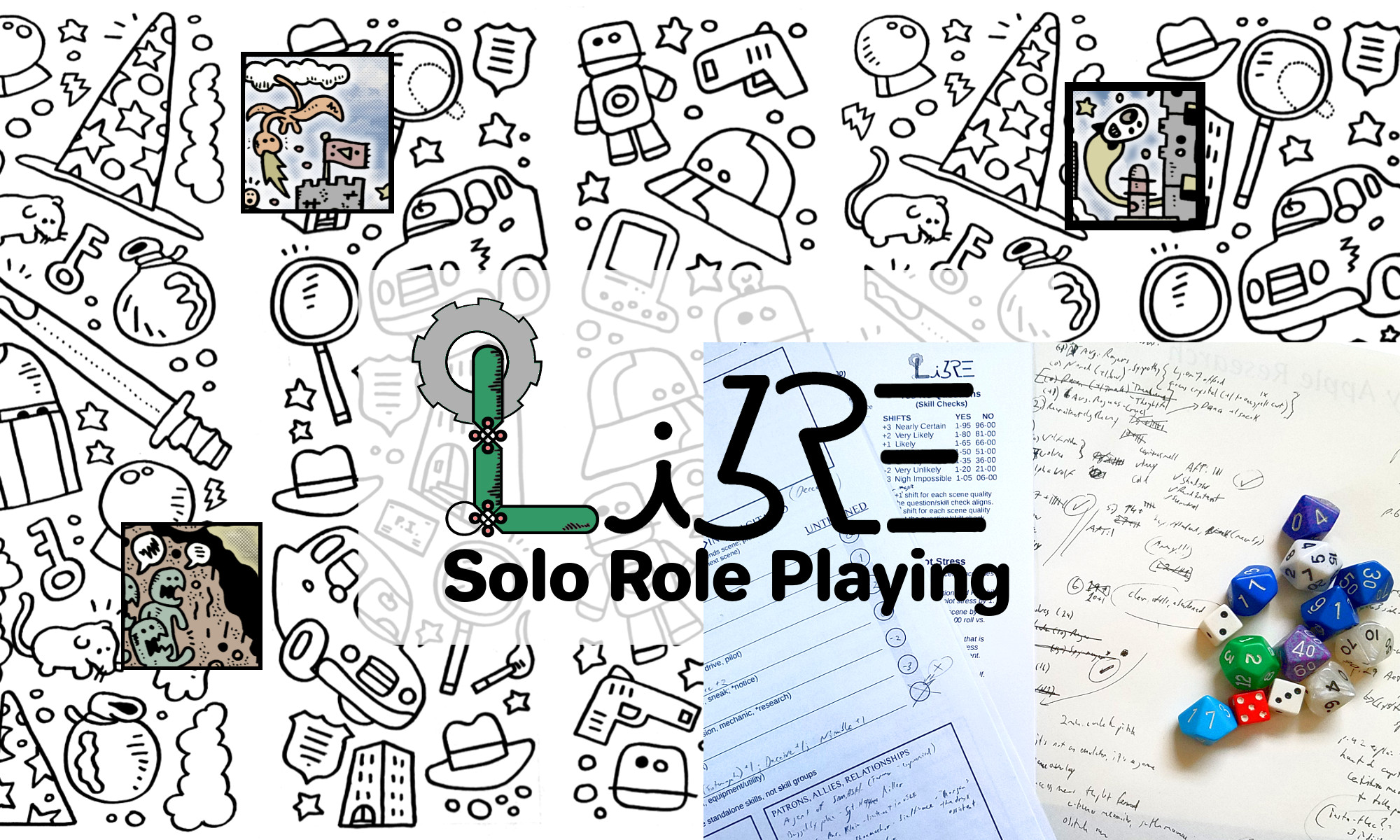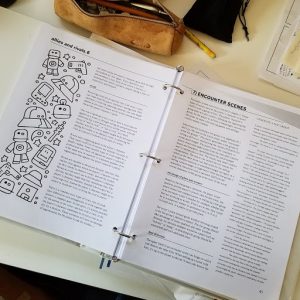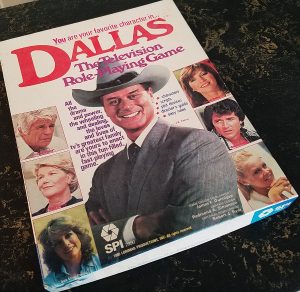I didn’t put much genre-specific advice into the book. I figured it was best to focus the book on the toolkit, add basics that show how it plays and let people hack their own way. But the guy who built it should probably show how mystery, and mystery horror, can work. Here are some pointers how to structure a mystery using Libre SRP. Strap in: This is going to be a long post with a lot of jargon.
Mystery stories (investigations or horror) require a lot of speaking to people and looking for stuff. That relies heavily on “structured questions for persons” (p.32) for interviews, the tools for “exposing the unknown” (p.31), and its variant that asks for trouble, “exposing the unknown: detecting trouble” (p.36). It’s also nice but not necessary to have an ally in mysteries. Allies can both assist and cause trouble. That’s really helpful.
So, let’s start off with our opening cutscene and get a mission. By the way, while it’s called a mission, it is just a story catalyst to give the player a focus for the protagonist.
- If your protagonist has a regular patron (person or organization), or is an investigator for hire, might as well use that route to formulate the starting cutscene. But you can take very different routes, too. For a mystery horror story, I once started with a protagonist who moved into an old Victorian house, next to a cemetery at the edge of a rural northern New England town (cliche alert!) That story used a randomly rolled person as the next-door neighbor, and the structured questions from the cordial conversation during move-in day kicked off the mission.
- Libre SRP always gives you the option to choose your mission (d20) instead of rolling randomly. If you want an investigation, choose “investigate” for crimes or “research” for something more open-ended. Appendix 4 (p.123-124) gives brief descriptions and sample target types (place, person, item) for this type of mission. You may choose, but I find rolling randomly produces results that prompt follow-up yes-no questions and interesting results.
- Get a good jump on the story by asking all the structured questions and follow-ups you can, and as many yes-no questions as you can think of, in the starting cutscene. For mystery, look for starting answers for who-what-when-where-why? For a horror twist, as with the graveyard-adjacent rural victorian house, tilt your yes-no questions toward the genre. That means follow-ups to your structured questions for further details. Here are some examples:
– ‘does s/he know anything about the house’s last occupants?’ [yes could prompt a person (d100) roll, to describe the people (through a dark lens). You may choose to roll a trait (d20). You may have more detailed questions, if the other person knows and is willing to talk about it, regarding their personality and habits.]
– ‘does s/he know what happened to those occupants?’ [yes could prompt the follow-up question: ‘did they come to a foul end?’ another yes could prompt: ‘do they know who was responsible?’ and that could prompt a person (d100) roll for the perpetrator(s), through a dark lens. No could instead prompt the follow-up question: ‘did they simply disappear?’]
– ‘does the person reference an item to help with the mission:’ You may gather more detailed questions about the item’s relationship to the mystery, if the other person knows and is willing to discuss it.]
– ‘is there another person to contact with more information?’ is a must-ask, generating a person (d100).
– If you decide at some point the protagonist has to make a social skill check to draw out information and it fails, that might invite an immediate empathy skill check follow-up: If successful, it could reveal a rationale (d20) related to the conversation, which the player can use to ask more yes-no questions, and get to the bottom of what the rationale means. An empathy skill check failure typically at least ends the conversation.
On the horror front, there is no sanity mechanic for Libre SRP. I throw it into the big bucket of “asking for trouble”. When the protagonist sees a supernatural phenomenon or unspeakable horror, ask: “does my player’s character go temporarily insane?” You may back it up with yes-no questions such as: “does s/he flee gibbering madly?” or “does s/he faint and collapse, unconscious (treat as incapacitated)?”
On to obstacle scenes. Assuming a gritty setting, most of the protagonist’s time will be spent on research, notice and social skill groups. Sneak, streetwise, athletics and drive skill groups can help round out scenes. Use the information and cues from prior scene(s) to set up the next scene and come up with skill challenges you think you’ll face.
- As with cutscenes, your investigator needs to ask lots of questions to further the investigation. But in obstacle scenes, at least some of those social skill checks need to be opposed (and moderate difficulty or harder to succeed) to qualify for meaningful success: Your protagonist needs to draw information out of someone unwilling to disclose it. Brush up on “consequences for failed social skill checks” and “social skill consequences” sidebar (p.30-31). Gather information can be a backdoor alternative that behaves a bit like research and a bit like structured questions, without being either. But information gathering is limited to what can be gleaned from listening in on gossip and general ‘word on the street’. Make sure you have an idea of consequence for failure before making social skill check rolls. Use yes-no questions if you need them to hone in on a consequence if the skill check fails: Try always to have a consequence in your possibilities that is related to the dangers of the mystery.
- Empathy is a handy skill that can detect a rationale (d20), which usually prompts new ideas and follow-up yes-no questions to clarify the result. That can lead to further insights.
- Notice is handy for finding hidden compartments in boxes or drawers, secreted passageways behind bookcases, bricked-up ritual rooms, concealed basement trapdoors leading to tunnels, and so forth. With a successful notice you can come up with the most logical thing(s) that might be found, based on what was being searched. Ask yes-no questions (limited by the “rule of three”) about what the found thing might be, and additional yes-no questions to clarify. Notice skill checks typically reveal an item (d100) or a concealed civilized place (d20). As with social skill checks, have the consequences for failure in mind. For notice skill checks, they are usually based off time being wasted, and something bad happening during that time (p.25). The specifics should relate to your own story’s elements. While the protagonist is in the basement, maybe something is stirring in the attic; or the homeowner, home inspector, contractor, nosy neighbor, rival or other problematic unexpected guest shows up. Catching the protagonist acting suspiciously might force an awkward explanation, a follow-up social skill check that might make things better or worse.
- Research is also handy for uncovering either a new person (d100), or new rationale (d20), or a place (d20). It can reveal insights about places, persons and items. Treat it like notice; consequences for failure tend toward catching unwanted attention; depending who finds out about the investigator’s snooping, repercussions can range from embarrassing to potentially deadly.
- Throw in the towel a lot. I wrote about this topic separately. In a group RPG, players trying to solve a mystery will prod at ideas and leads, abandon ideas and switch tracks in practical ways. If a scene starts off with failures and the protagonist can close it cleanly (no active conflict, no outstanding trouble/consequences, able to leave the area at will), just shut it down and start fresh with a different route. Why stubbornly persist with a scene that starts with a downward spiral? Push the scene only if you’re already deeply committed — if you have two successful skill checks and asked for trouble twice, and meaningful success is in your grasp.
Unexpected events where a foe shows up can be pivotal to pushing the story forward. You’ll need to decide what random rolled-up foe (if any) makes logical sense, and cross-map to an equivalent alternative foe type as necessary. Zombies, cultists, gangsters — none of the above are likely to show up while the protagonist is searching records at the town hall mid-day. But if the investigator is alone at night? In a gritty setting, even one rolled foe can be a moderate or harder challenge to the protagonist, which means beating that foe can contribute a skill check to meaningful success. Foes can also reveal vital information: There’s structured questions for foes (p.33) for the living. For the dead (or undead) notice and/or follow-up research skill check might also work to reveal a key item, or give an after-the-fact rationale that could be a clue.
How to solve the mystery? There’s a dangerous way: You can aim for an obstacle scene where the protagonist accuses a/the prime suspect as part of the story, and part of the skill check attempts for meaningful success. Maybe you plan to have the protagonist use an intimidate skill check in the scene to force a confession out of the suspect. If you get to that point of the scene smoothly and if the skill check succeeds, it’s a form of exposing the unknown that may either extract a confession (if the follow-up yes-no question fingers the suspect as the criminal), or else double down on proclaiming innocence (if the follow-up yes-no question does not). If the suspect claims innocence, maybe further interrogation might yield some useful information (or not — it’s a continuation of structured questions for foes). Or maybe the investigator just hit a dead end. On the other hand if that intimidate skill check to extract a confession fails, you’re in for an interesting, potentially very messy consequence. Whatever the details of the consequence, it should hamper the protagonist from pulling the same tactic on another suspect in the same scene.
Another, safer way to wrap up a mystery is to get the meaningful successes of the investigation completed first, then use the final cutscene to make an accusation and see what comes of it. You’ve secured what you need for a positive outcome: Whatever happens of the protagonist fingering the suspect (as above), in a final cutscene it won’t totally up-end the scene. But even if all goes horribly wrong for the protagonist in the final cutscene, the positive outcome is already ordained. It means your protagonist might have guessed wrong and bollixed everything, but you can still narrate that authorities then used the investigator’s gathered clues to find and prosecute the right criminal, for example. Or it just means the investigator got paid, and the case remains open but no longer the investigator’s concern: That’s still a positive outcome for the protagonist, right?
So, where lurk the unspeakable eldritch horrors from beyond? Well, if it makes sense in the scene, they can show up with an unexpected event result that generates a “monster/beast”. Or you can put together an encounter scene generate a random monster/beast, and use its point value to spend down the foe budget. You might multiply the number of beasts to spend down the budget, or mix in cultists and other human(oid) foes. But if you choose to put together an encounter scene to confront your foe(s) directly and see who wins — as we’ve all read in the genre stories, that usually doesn’t end well.
That’s all I have for now on mysteries. Tilted yes-no questions, asking for trouble that relates to the mystery, revelations from research / social / streetwise skills and that answer structured questions and expose the unknown, and unexpected events that turn up foes: These are your core tools for these types of stories.


